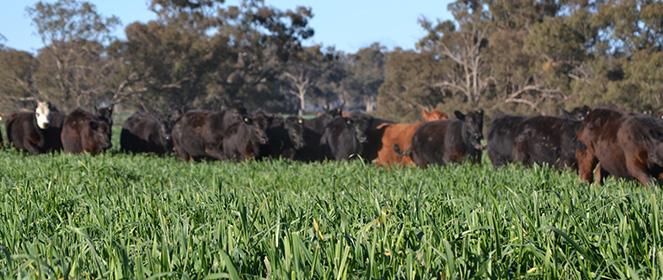
3 minute read
Managing winter cereal crops for maximum performance
With most regions of Australia experiencing good seasonal conditions heading into winter, management of autumn-sown forage and dual-purpose cereal grazing crops to fill winter feed gaps is critical to maximising both crop and livestock performance.
GRAZING MANAGEMENT AND STOCKING RATES
Advertisement
Under good growing conditions, most cereals can be grazed 6-8 weeks after plant emergence. Any seed treatments used for disease and insect control may delay the time to first grazing, depending on their withholding periods.Stocking densities will also depend on animal production targets and available dry matter.
Early dry matter production of cereals can be deceptive. Knowing how much dry matter is available will influence stocking rates for early grazing. The true forage types, such as Bond oats, have a semi-erect to erect growth habit, so are more suited to cattle grazing.
Dual-purpose cereals, especially those with a strong vernalisation requirement (winter habit), are more prostrate in growth and more suitable for sheep grazing. Where grazing and grain recovery is the preferred option for dual-purpose cereals, awnless varieties should be considered for frost-prone areas.
Many livestock producers are moving from a monoculture cereal to planting companion species (for example, ryegrasses, vetch, brassicas and turnips) with their grazing cereals, to improve animal diets and extend the quality of the feed on offer later into the season.
The number of grazings is largely dependent on the time of sowing, growing conditions and grazing system. In 2020, many cereal crops were not grazed (due to low stock numbers and good growth), so producers took the option of early silage to replenish fodder supplies and build drought resilience.
The latest grazing time and severity of grazing on crops intended for grain recovery or silage/hay production should be based on growth stage. Ideally, stock should be removed by growth stage Z31. Grazing later than this stage will not only reduce dry matter recovery but also delay maturity and grain recovery. However, the losses associated with any decrease in grain yield can be outweighed by the income generated from liveweight gain, especially with current lamb and cattle prices.
FERTILISER
Nutritional requirements vary with climate, soil type and paddock history. Where nitrogen fertiliser is required, split applications are suitable for forage and dual-purpose cereals after grazings, when for hay/silage or grain production.
WEED CONTROL
Weed control is important to maintain clean paddocks in a rotation in preparation for future crops or pastures and also to produce the highest-quality grain or hay/silage possible. This is especially important in early-sown crops where weed germinations did not occur before planting. Spray-grazing techniques can also be used effectively for many broadleaf weeds, especially where feed is short. Timing of weed control options needs to be matched with grazing requirements so that chemical withholding periods are observed.
LIVESTOCK HEALTH
Several health conditions or mineral and vitamin imbalances can affect stock grazing cereals, so growers should have vaccination and supplementation plans in place.
PLANNING FOR SPRING SILAGE/HAY OPTIONS
In tablelands and higher rainfall areas, late winter/early spring planting options can be considered for grazing, hay or silage. Paddock preparation should be undertaken well in advance of anticipated sowing windows to take advantage of any rainfall events. Options to sow can include straight cereal or combinations of cereal/field pea or cereal/vetch mixes in different combinations to maximise the quality of the hay or silage being produced.
If planting mixes, it is important to understand the growth habit and maturity of the varieties being sown to synchronise flowering for the ideal stage of cutting. Choose a cereal with a spring habit that is preferably awnless (wheat), or has reduced awns (triticale), especially for hay production. Seeding rates need to be at the higher end as spring habit cereals produce fewer tillers than cereals sown in autumn. Paddock selection (e.g., free of rocks) is also important if considering using contractors to make hay or silage.










